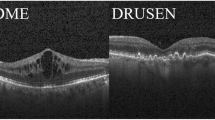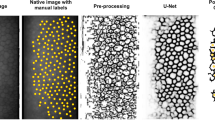Abstract
Classifying a particular image from a data set is a complex work for any image analyst. Generally, the output of medical image scan gives numerous images for analysis. In that, the image analyst has to manually predict a better noiseless image for computer-assisted image process program. Manual verification of all the output images from the scan device consumes a lot of time in predicting the abnormality of a patient. The proposed capsule network for noiseless image algorithm assists the image analyst by classifying the noiseless image from the data set for further computer-assisted image enhancement or segmentation program. The proposed algorithm performance is evaluated and compared with the existing algorithms in terms of accuracy, sensitivity, specificity, positive predictive value, and negative predictive value.








Similar content being viewed by others
References
Agrawal P, Kaushik S (2019) Image completion of highly noisy images using deep learning. In: International conference on computational vision and bio inspired computing. Springer, Cham, pp 1031–1043
Arunkumar N, Mohammed MA, Mostafa SA, Ibrahimb DA, Rodrigues JJPC, de Albuquerque VHC (2020) Fully automatic model-based segmentation and classification approach for MRI brain tumor using artificial neural networks. Concurr Comput Pract Exp 32(1):e4962
Cai Z, Saberian M, Vasconcelos N (2015) Learning complexity-aware cascades for deep pedestrian detection. In: Proceedings of the IEEE international conference on computer vision, pp 3361–3369
Coudray N, Ocampo PS, Sakellaropoulos T, Narula N, Snuderl M, Fenyö D, Moreira AL, Razavian N, Tsirigos A (2018) Classification and mutation prediction from non-small cell lung cancer histopathology images using deep learning. Nat Med 24(10):1559
Deng F, Shengliang P, Chen X, Shi Y, Yuan T, Shengyan P (2018) Hyperspectral image classification with capsule network using limited training samples. Sensors 18(9):3153
Devi BA, Pallikonda Rajasekaran M (2019) Performance evaluation of MRI pancreas image classification using artificial neural network (ANN). In: Smart intelligent computing and applications. Springer, Singapore, pp 671–681
Ferentinos KP (2018) Deep learning models for plant disease detection and diagnosis. Comput Electron Agric 145:311–318
Gargeya R, Leng T (2017) Automated identification of diabetic retinopathy using deep learning. Ophthalmology 124(7):962–969
Ghassemi N, Shoeibi A, Rouhani M (2020) Deep neural network with generative adversarial networks pre-training for brain tumor classification based on MR images. Biomed Signal Process Control 57:101678
Jacob IJ (2019) Capsule network based biometric recognition system. J Artif Intell 1(02):83–94
Jahromi MK, Kafieh R, Rabbani H, Dehnavi AM, Peyman A, Hajizadeh F, Ommani M (2014) An automatic algorithm for segmentation of the boundaries of corneal layers in optical coherence tomography images using gaussian mixture model. J Med Signals Sens 4(3):171
Korbar B, Olofson AM, Miraflor AP, Nicka CM, Suriawinata MA, Torresani L, Suriawinata AA, Hassanpour SS (2017) Deep learning for classification of colorectal polyps on whole-slide images. J Pathol Inf 8:30
Koresh HJD, Chacko S (2018) Identification of optimum image capturing technique for corneal segmentation—a survey. In: International conference on ISMAC in computational vision and bio-engineering. Springer, Cham, pp 715–726
Kumar AD (2018) Novel deep learning model for traffic sign detection using capsule networks. arXiv preprint arXiv:1805.04424
Kurup RV, Anupama MA, Vinayakumar R, Sowmya V, Soman KP (2019) Capsule network for plant disease and plant species classification. In: International conference on computational vision and bio inspired computing. Springer, Cham, pp 413–421
Lakshmanaprabu SK, Mohanty SN, Shankar K, Arunkumar N, Ramirez G (2019) Optimal deep learning model for classification of lung cancer on CT images. Future Gener Comput Syst 92:374–382
Lee CS, Baughman DM, Lee AY (2017a) Deep learning is effective for classifying normal versus age-related macular degeneration OCT images. Ophthalmol Retina 1(4):322–327
Lee H, Tajmir S, Lee J, Zissen M, Yeshiwas BA, Alkasab TK, Choy G, Do S (2017b) Fully automated deep learning system for bone age assessment. J Digit Imaging 30(4):427–441
Li Y, Qian M, Liu P, Cai Q, Li X, Guo J, Yan H et al (2019) The recognition of rice images by UAV based on capsule network. Clust Comput 22(4):9515–9524
Mendes TSG, Poz APD (2019) Urban road classification in geometrically integrated high-resolution RGB aerial and laser-derived images using the artificial neural network classification method. Int J Image Data Fusion 10(1):58–78
Nithya A, Appathurai A, Venkatadri N, Ramji DR, Palagan CA (2020) Kidney disease detection and segmentation using artificial neural network and multi-kernel k-means clustering for ultrasound images. Measurement 149:106952
Paoletti ME, Haut JM, Fernandez-Beltran R, Plaza J, Plaza A, Li J, Pla F (2018) Capsule networks for hyperspectral image classification. IEEE Trans Geosci Remote Sens 57(4):2145–2160
Ponnusamy R, Sathiamoorthy S (2019) Bleeding and Z-line classification by DWT based SIFT using KNN and SVM. In: International conference on computational vision and bio inspired computing. Springer, Cham, pp 679–688
Ren H, Lu H (2018) Compositional coding capsule network with k-means routing for text classification. arXiv preprint arXiv:1810.09177
Shaukat F, Raja G, Ashraf R, Khalid S, Ahmad M, Ali A (2019) Artificial neural network based classification of lung nodules in CT images using intensity, shape and texture features. J Ambient Intell Hum Comput 10:4135–4149
Smys S, Chen JI-Z, Mohammadi S, Rocha A (2019) Capsule networks and autonomous systems. Int J Intell Unmanned Syst
Sun Y, Chen Y, Wang X, Tang X (2014) Deep learning face representation by joint identification-verification. In: Advances in neural information processing systems, pp 1988–1996
Vijayakumar T (2019) Comparative study of capsule neural network in various applications. J Artif Intell 1(01):19–27
Vinyals O, Blundell C, Lillicrap T, Wierstra D (2016) Matching networks for one shot learning. In: Advances in neural information processing systems, pp 3630–3638
Wang D, Khosla A, Gargeya R, Irshad H, Beck AH (2016) Deep learning for identifying metastatic breast cancer. arXiv preprint arXiv:1606.05718
Wang W-Y, Li H-C, Pan L, Yang G, Du Q (2018) Hyperspectral image classification based on capsule network. In: IGARSS 2018 IEEE international geoscience and remote sensing symposium. IEEE, pp 3571–3574
Wei X, Li W, Zhang M, Li Q (2019) Medical hyperspectral image classification based on end-to-end fusion deep neural network. IEEE Trans Instrum Meas
Xiang C, Zhang L, Tang Y, Zou W, Chen X (2018) MS-CapsNet: a novel multi-scale capsule network. IEEE Signal Process Lett 25(12):1850–1854
Zhu K, Chen Y, Ghamisi P, Jia X, Benediktsson JA (2019) Deep convolutional capsule network for hyperspectral image spectral and spectral-spatial classification. Remote Sens 11(3):223
Acknowledgements
Data set downloaded from https://sites.google.com/site/hosseinrabbanikhorasgani/datasets-1 and associated with the publication (Jahromi et al. 2014).
Author information
Authors and Affiliations
Corresponding author
Ethics declarations
Conflict of interest
All author states that there is no conflict of interest. Humans and animals are not involved in this research work.
Additional information
Communicated by V. Loia.
Publisher's Note
Springer Nature remains neutral with regard to jurisdictional claims in published maps and institutional affiliations.
Rights and permissions
About this article
Cite this article
Koresh, H.J.D., Chacko, S. Classification of noiseless corneal image using capsule networks. Soft Comput 24, 16201–16211 (2020). https://doi.org/10.1007/s00500-020-04933-5
Published:
Issue Date:
DOI: https://doi.org/10.1007/s00500-020-04933-5




